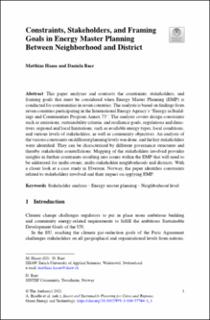Constraints, Stakeholders, and Framing Goals in Energy Master Planning Between Neighborhood and District
Chapter
Published version
Permanent lenke
https://hdl.handle.net/11250/2727571Utgivelsesdato
2021Metadata
Vis full innførselSamlinger
- Publikasjoner fra CRIStin - SINTEF AS [5801]
- SINTEF Community [2248]
Originalversjon
10.1007/978-3-030-57764-3_1Sammendrag
This paper analyzes and contrasts the constraints, stakeholders, and framing goals that must be considered when Energy Master Planning (EMP) is conducted for communities in seven countries. The analysis is based on findings from seven countries participating in the International Energy Agency’s “Energy in Buildings and Communities Program Annex 73”. The analysis covers design constraints such as emissions, sustainability criteria, and resilience goals, regulations and directives, regional and local limitations, such as available energy types, local conditions, and various levels of stakeholders, as well as community objectives. An analysis of the various constraints on different planning levelswas done, and the key stakeholders were identified. They can be characterized by different governance structures and thereby stakeholder constellations. Mapping of the stakeholders involved provides insights in further constraints resulting into issues within the EMP that will need to be addressed for multi-owner, multi-stakeholder neighborhoods and districts. With a closer look at a case study in Elverum, Norway, the paper identifies constraints related to stakeholders involved and their impact on applying EMP.

